Other Pesky Critters HORT 378 Integrated Pest/Disease Management


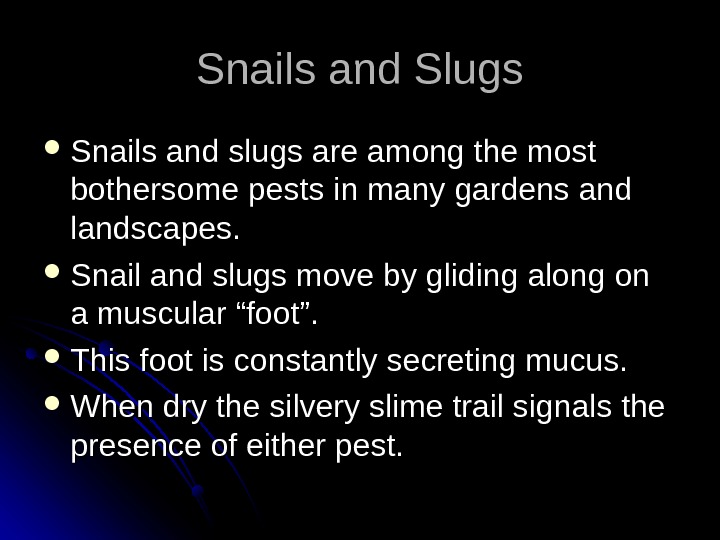



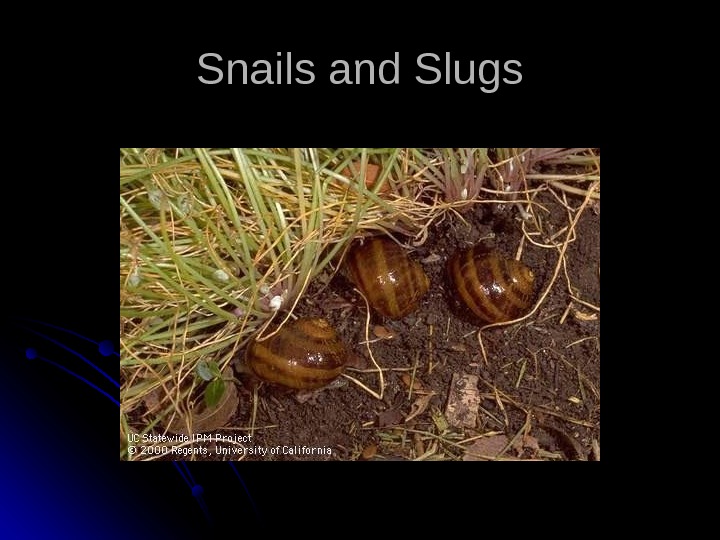
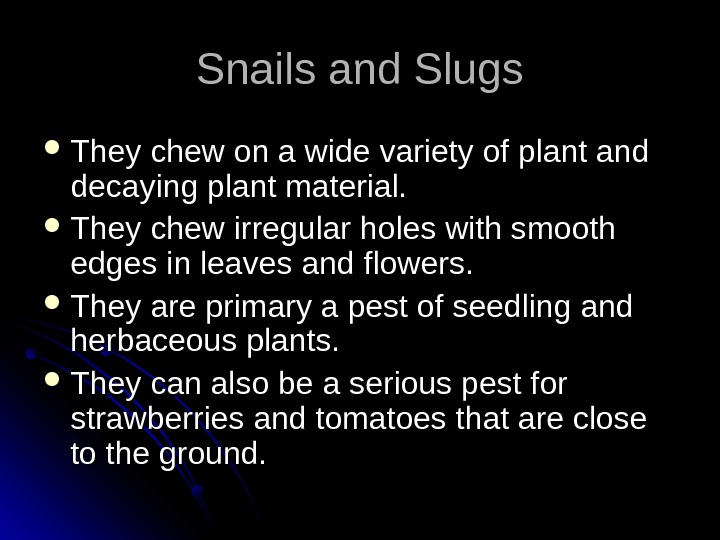

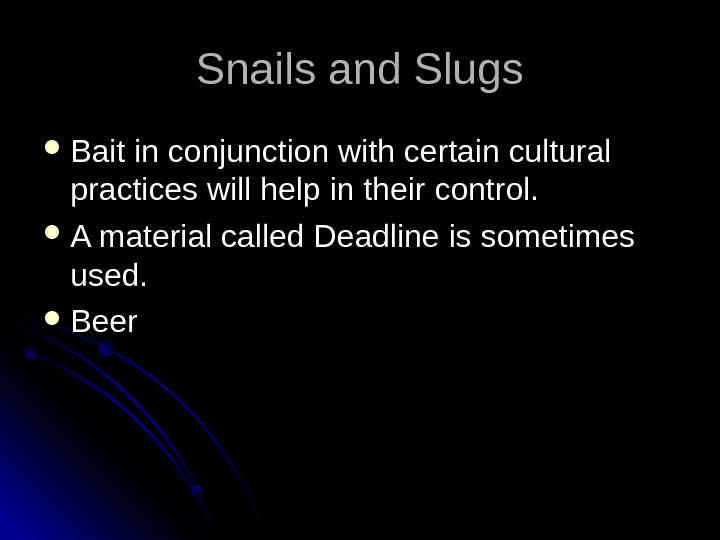








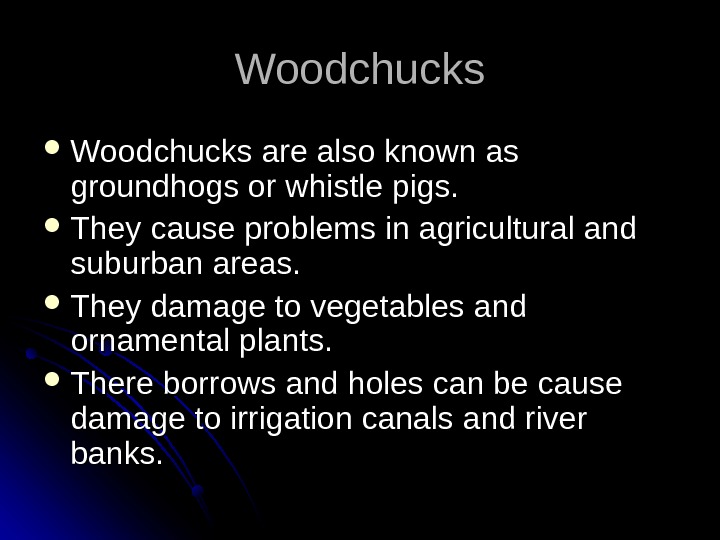



















other_pesky_critters.ppt
- Размер: 795 Кб
- Количество слайдов: 37
Описание презентации Other Pesky Critters HORT 378 Integrated Pest/Disease Management по слайдам
 Other Pesky Critters HORT 378 Integrated Pest/Disease Management
Other Pesky Critters HORT 378 Integrated Pest/Disease Management
 Snails and Slugs Snails and slugs are among the most bothersome pests in many gardens and landscapes. Snail and slugs move by gliding along on a muscular “foot”. This foot is constantly secreting mucus. When dry the silvery slime trail signals the presence of either pest.
Snails and Slugs Snails and slugs are among the most bothersome pests in many gardens and landscapes. Snail and slugs move by gliding along on a muscular “foot”. This foot is constantly secreting mucus. When dry the silvery slime trail signals the presence of either pest.
 Snails and Slugs
Snails and Slugs
 Snails and Slugs
Snails and Slugs
 Snails and Slugs Slug and snails are hermaphrodites. Snails and slugs are most active at night and or cloudy or foggy days. They seek hiding places out of the heat or bright light. The most common snail is the brown garden snail, imported from France in the 1850’s for use as food.
Snails and Slugs Slug and snails are hermaphrodites. Snails and slugs are most active at night and or cloudy or foggy days. They seek hiding places out of the heat or bright light. The most common snail is the brown garden snail, imported from France in the 1850’s for use as food.
 Snails and Slugs
Snails and Slugs
 Snails and Slugs They chew on a wide variety of plant and decaying plant material. They chew irregular holes with smooth edges in leaves and flowers. They are primary a pest of seedling and herbaceous plants. They can also be a serious pest for strawberries and tomatoes that are close to the ground.
Snails and Slugs They chew on a wide variety of plant and decaying plant material. They chew irregular holes with smooth edges in leaves and flowers. They are primary a pest of seedling and herbaceous plants. They can also be a serious pest for strawberries and tomatoes that are close to the ground.
 Snails and Slugs There are several ways to control these pests. Remove hiding places: boards, weedy areas around trees trunks, etc. Switching from sprinkler to drip irrigation. In the small landscape hand picking is sometime effective.
Snails and Slugs There are several ways to control these pests. Remove hiding places: boards, weedy areas around trees trunks, etc. Switching from sprinkler to drip irrigation. In the small landscape hand picking is sometime effective.
 Snails and Slugs Bait in conjunction with certain cultural practices will help in their control. A material called Deadline is sometimes used. Beer
Snails and Slugs Bait in conjunction with certain cultural practices will help in their control. A material called Deadline is sometimes used. Beer
 Mammals as Pests Some mammals are considered pests because of aesthetics, or damage they cause, or diseases they carry. : rabies or Blubonque plaque.
Mammals as Pests Some mammals are considered pests because of aesthetics, or damage they cause, or diseases they carry. : rabies or Blubonque plaque.
 Mice and Rats Mice and rats can be a problem in urban, suburban and rural areas. These rodents eat the same food as humans and get plenty of food from gardens, fruit and nut trees, and garbage. They have been a problem on farms where food is plentiful and many convenient nesting sites.
Mice and Rats Mice and rats can be a problem in urban, suburban and rural areas. These rodents eat the same food as humans and get plenty of food from gardens, fruit and nut trees, and garbage. They have been a problem on farms where food is plentiful and many convenient nesting sites.
 Mice and Rats
Mice and Rats
 Mice and Rats
Mice and Rats
 Mice and Rats Six major problems caused by mice and rats: 1. 1. The eat food and contaminate it with urine and feces. 2. 2. They gnaw into materials: paper, books, etc, and electrical wiring that shorts out and cause fires.
Mice and Rats Six major problems caused by mice and rats: 1. 1. The eat food and contaminate it with urine and feces. 2. 2. They gnaw into materials: paper, books, etc, and electrical wiring that shorts out and cause fires.
 Mice and Rats 3. 3. Rats will bit people and kill small animals: baby chicks, etc. 4. 4. They spread many diseases. 5. 5. Rats can damage ornamental plants by burrowing through the roots or feeding on new growth. 6. 6. Socially unacceptable.
Mice and Rats 3. 3. Rats will bit people and kill small animals: baby chicks, etc. 4. 4. They spread many diseases. 5. 5. Rats can damage ornamental plants by burrowing through the roots or feeding on new growth. 6. 6. Socially unacceptable.
 Mice and Rats Control Sanitation first Store garbage in rodent proof containers. Make sure garbage lids are securely fastened Clean up spilled or unused pet foods. Do not scatter food for birds. Eliminate bird feeding if these rodents become a problem.
Mice and Rats Control Sanitation first Store garbage in rodent proof containers. Make sure garbage lids are securely fastened Clean up spilled or unused pet foods. Do not scatter food for birds. Eliminate bird feeding if these rodents become a problem.
 Mice and Rats Traps Poison bait – safeguard children and pets. Keep clean the area clean of food and places where they can hide. A good cat.
Mice and Rats Traps Poison bait – safeguard children and pets. Keep clean the area clean of food and places where they can hide. A good cat.
 Woodchucks are also known as groundhogs or whistle pigs. They cause problems in agricultural and suburban areas. They damage to vegetables and ornamental plants. There borrows and holes can be cause damage to irrigation canals and river banks.
Woodchucks are also known as groundhogs or whistle pigs. They cause problems in agricultural and suburban areas. They damage to vegetables and ornamental plants. There borrows and holes can be cause damage to irrigation canals and river banks.
 Woodchucks
Woodchucks
 Woodchucks There holes can be a nuisance for farm equipment to ride over and can cause damage to farm equipment. Their primary predators are foxes, hawks, coyotes, dogs and man.
Woodchucks There holes can be a nuisance for farm equipment to ride over and can cause damage to farm equipment. Their primary predators are foxes, hawks, coyotes, dogs and man.
 They are one on the few mammals that hibernate in the winter. Woodchucks primarily feed in the early morning and evening hours. They are strict herbivores and will feed on almost anything
They are one on the few mammals that hibernate in the winter. Woodchucks primarily feed in the early morning and evening hours. They are strict herbivores and will feed on almost anything
 Woodchucks Traps Exclusion Fumigants Shooting Automobiles
Woodchucks Traps Exclusion Fumigants Shooting Automobiles
 Zeroing in on your crops and landscape.
Zeroing in on your crops and landscape.
 Moles The most wide spread specie of moles east of the Rocky Mountains is the eastern mole (( Scalopus aquaticas ). ). It is 6 -8 inches long, short legged, blackish, heavy-bodied, with a long snout, short tail and broadened , shovel like front feet. The make subsurface tunnels, where a ridge of sod several inches wide is pushed up at least two inches.
Moles The most wide spread specie of moles east of the Rocky Mountains is the eastern mole (( Scalopus aquaticas ). ). It is 6 -8 inches long, short legged, blackish, heavy-bodied, with a long snout, short tail and broadened , shovel like front feet. The make subsurface tunnels, where a ridge of sod several inches wide is pushed up at least two inches.

 These subsurface tunnels are divided into feeding and main tunnels. The feeding tunnel tend to meander or wind back and forth. They commonly dead-end. Feeding tunnels are created when searching for food and are rarely reused.
These subsurface tunnels are divided into feeding and main tunnels. The feeding tunnel tend to meander or wind back and forth. They commonly dead-end. Feeding tunnels are created when searching for food and are rarely reused.
 Main tunnels are usually straighter and connect other tunnels or mounds of loose soil. They are used daily by the moles to get from place to place. They also trap earthworms that enter the tunnels.
Main tunnels are usually straighter and connect other tunnels or mounds of loose soil. They are used daily by the moles to get from place to place. They also trap earthworms that enter the tunnels.
 Control moles by setting traps across main tunnels. The harpoon trap is set by mashing a portion of the main tunnel and setting the trap across it so that the spring-loaded spikes are just penetrating the soil. As the mole comes through the tunnel and pushes up the soil and triggers the spring the trap is sprung and the mole is struck by the spikes
Control moles by setting traps across main tunnels. The harpoon trap is set by mashing a portion of the main tunnel and setting the trap across it so that the spring-loaded spikes are just penetrating the soil. As the mole comes through the tunnel and pushes up the soil and triggers the spring the trap is sprung and the mole is struck by the spikes

 Pocket Gophers Pocket gophers are brownish rodents that live in underground burrows. There are several species that live throughout the United States.
Pocket Gophers Pocket gophers are brownish rodents that live in underground burrows. There are several species that live throughout the United States.

 They feed on plant roots, bulbs, tubers, stems and leaves, as well as insects. They really like bulbs and tubers and cause heavy damage to flower beds. Burrows are constructed several inches below the surface of the soil, with loose soil piled into large mounds on the surface.
They feed on plant roots, bulbs, tubers, stems and leaves, as well as insects. They really like bulbs and tubers and cause heavy damage to flower beds. Burrows are constructed several inches below the surface of the soil, with loose soil piled into large mounds on the surface.
 Control Traps placed in the burrows are effective. Poisoned grain bait. Fumigants can be forced into the deeper burrows, but the gopher frequently plug these tunnels with soil to escape harm.
Control Traps placed in the burrows are effective. Poisoned grain bait. Fumigants can be forced into the deeper burrows, but the gopher frequently plug these tunnels with soil to escape harm.
 Pocket Gopher Trap
Pocket Gopher Trap
 Pocket Gopher Trap
Pocket Gopher Trap
 Setting Poison Bate for Pocket Gophers
Setting Poison Bate for Pocket Gophers
 Useless Fact Did you know that a goldfish has an attention span of three seconds.
Useless Fact Did you know that a goldfish has an attention span of three seconds.

